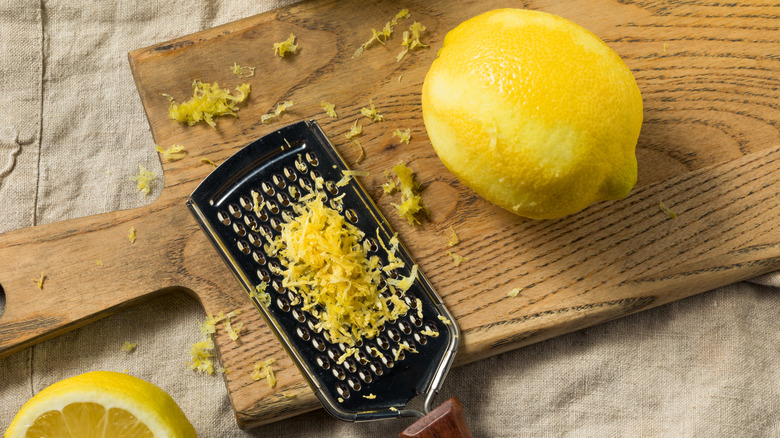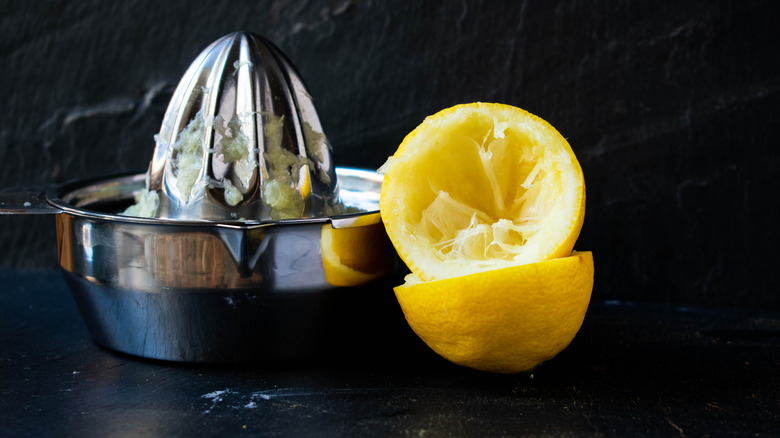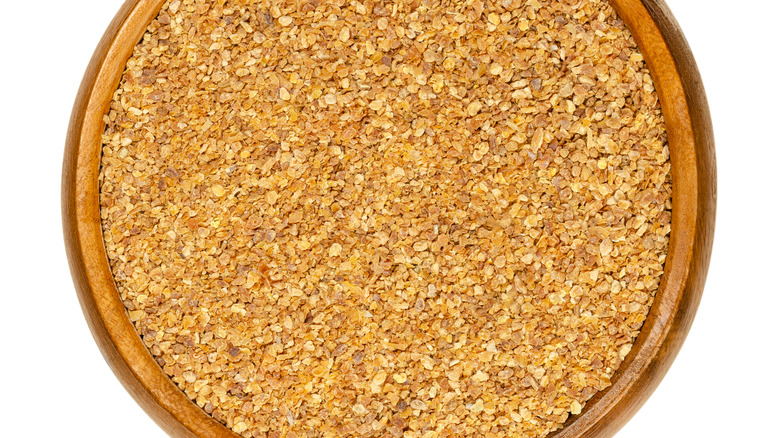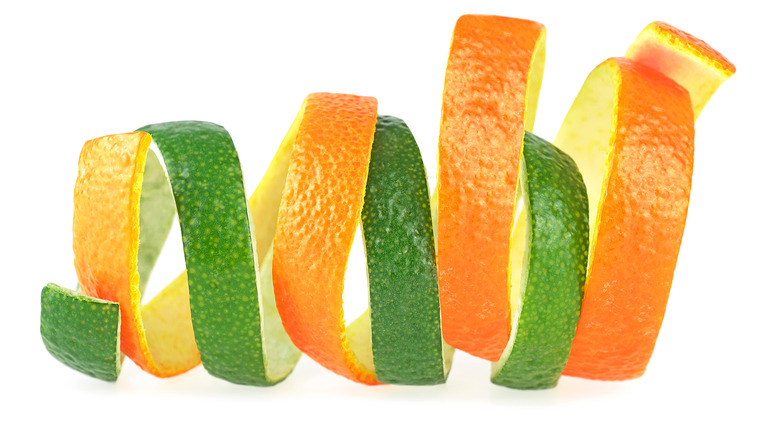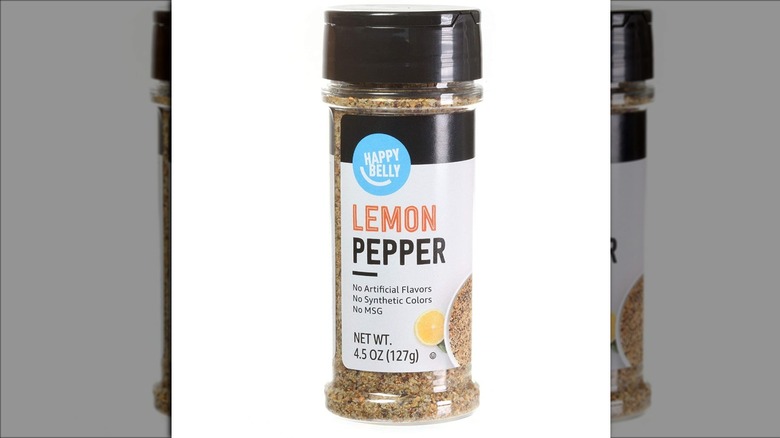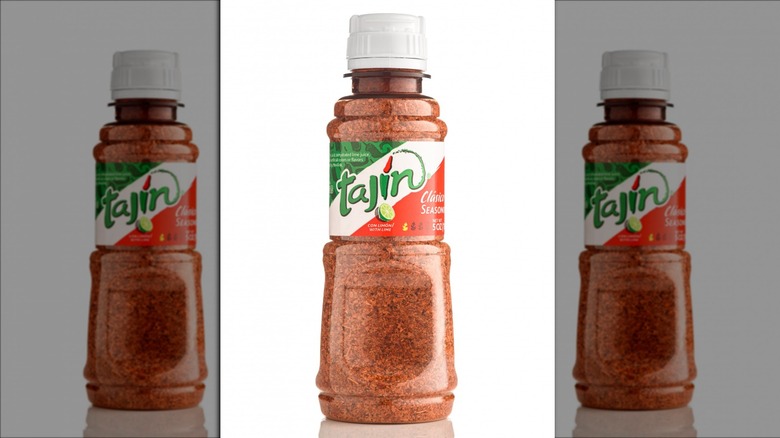6 Best Substitutes For Lemon Zest
We may receive a commission on purchases made from links.
Lemon zest, that thin yellow layer on the outside of a lemon's skin (as opposed to the thick white layer of pith on the inside), adds zip and zing to any recipe. You should definitely say yes to the zest! But what can you do if you're out of lemons, or you just don't feel like scraping your knuckles raw trying to zest with a box grater when that darn zester is buried at the bottom of the junk drawer again? (What, you don't even own a microplane zester? Shame on you for dissing Nigella Lawson's fave utensil.)
There are several different ingredients you may be able to use in place of lemon zest, depending on your recipe, per The Spruce Eats. While none of these suggestions will exactly duplicate the taste and texture of lemon zest itself, in some cases, you may find that you enjoy using the substitute even more than the original.
1. Lemon extract
Lemon extract, as MasterClass explains, is a liquid that's typically made by immersing lemon peels in alcohol. This is done, as the name implies, to extract their flavoring. In some cases, if an alcohol-free extract is desired, oil can be used in place of this medium. Lemon extract is typically used in baking to provide a lemony flavor without tartness, which is something that lemon zest will also do. As both products are derived from lemon peel and contain none of the acidic juice, they don't have too much sour power.
To use lemon extract in place of lemon zest, Master Class suggests doing the swap on a 1:1 basis. However, LeafTV says that lemon extract tends to have a more concentrated flavor than zest, so they suggest using just half the amount. If you are using a significant amount of extract — perhaps a tablespoon or so — you may wish to reduce the amount of liquid in the recipe accordingly. If you're just adding 1/2 teaspoon or so, it probably won't make too much difference.
2. Lemon juice
Lemon juice, obviously, is the juice that is squeezed from a lemon. You can also buy bottled lemon juice, but this tends to have an "off" flavor that makes it a less desirable substitute. In certain types of recipes, fresh lemon juice can be substituted for lemon zest, although, obviously, if you have the raw materials for the one, you probably have the materials for the other. (Unless, of course, you have just one lemon in the house and you've already used the zest in a different recipe.) Subbing lemon juice for lemon zest is a change that you might want to make in a recipe if you're looking for some of that sourness.
Lemon juice doesn't have as concentrated a flavor as lemon zest, so A Couple Cooks says you'll need to use a tablespoon of the stuff in place of 1/2 teaspoon of zest. (Again, you may need to reduce the liquid accordingly.) Lemon juice should not be added directly to milk or cream, however, as it is likely to cause these dairy products to curdle. Taste of Home also notes that you might not want to add too much lemon juice to baked goods if it's not already called for in the recipe. The acid it contains will react with the alkaline baking soda and/or powder and alter the texture of the finished product.
3. Dried lemon peel
Dried lemon peel, like lemon zest, is made from the outer part of a lemon rind. What makes it different from zest? Well, technically nothing, but most recipes calling for lemon zest are assuming you'll be using fresh zest. Dried lemon peel is zest that has, as its name indicates, been dried, something that allows it to last for a good long while. While Foodtasia says you can easily make your own dried lemon peel by simply allowing lemon zest to dry on its own, they also note that it is commercially available (and not all that cheap, either).
Should you happen to have dried lemon peel on hand, bear in mind that the drying process has concentrated its flavor quite a bit. Taste of Home says that if you're using it in place of fresh zest, you should only use 1/3 of what is called for in the recipe. This means if you need a tablespoon of zest, you'll be using just a teaspoon of the dried stuff.
4. Zest from a different type of citrus
Lemon may be one of the most versatile fruits in the citrus family for culinary purposes as it features prominently in dishes both sweet and savory as well as in numerous beverages. There are, however, many other types of citrus fruits — more than 100 in all, according to Leafy Place. While you may not have any yuzu, pomelos, or kumquats ready to hand, you might be able to root around in your fruit bin and come up with a lime or an orange.
Of these two fruits, lime zest is going to give you a flavor closest to lemon, and can be used in place of lemon zest for just about any type of recipe. Taste of Home says to substitute lime zest for lemon zest on a 1:1 basis. Orange zest has a somewhat different flavor profile, but it may also work well for you, particularly in something sweet like a dessert where you don't mind shifting the flavor from lemon to orange. Again, you can use an amount equal to the lemon zest you're replacing.
5. Lemon pepper
Lemon pepper is a seasoning that's widely available on most supermarket shelves, and you may have a jar of it in your own pantry. In its commercial version, it's akin to a seasoned salt, as it contains a significant amount of that ingredient. Another main ingredient is black pepper, of course, and store-bought seasoning may get its lemon flavor from lemon oil. Additional flavorings may include onion, garlic, and sugar. Foodtasia says you can also make your own lemon pepper, providing a simple DIY recipe that just uses dried lemon zest, pepper, and salt.
Whether you are using a homemade version or store-bought lemon pepper, there are certain circumstances under which you can swap it out for lemon zest. Taste Essence suggests you can use it anywhere lemon zest is used strictly for garnishing purposes, presumably on savory dishes. Reddit suggests you can also use it when seasoning those same savory dishes. As one person put it when asked whether lemon pepper could work in place of zest, "In a chicken dish, sure. In a lemon meringue pie, prolly not." There is no set proportion that is recommended for such a substitution, but we suggest starting on a 1:1 basis and reducing the amount of salt and pepper accordingly.
6. Tajín
If you don't mind going in a bold new direction with your dish, consider using Tajín as a lemon zest substitute. Tajín is a Mexican seasoning blend made from salt, lime, and chile peppers; it's kind of like lemon pepper's kicked-up cousin. While Tajín is a condiment that's frequently used to season meats and veggies, it is making inroads in the dessert arena, too. Tajín is a must for mangonadas (even Baskin-Robbins knows it's true), and Tajín-sprinkled chocolate-dipped strawberries are a thing now. The Disney Food Blog also suggests using Tajín as a topping for Disneyland's famous Dole Whip.
With that in mind, substitute Tajín for lemon zest wherever and however you dare. Again, there's no officially sanctioned ratio, but bear in mind that you'll be getting a significant amount of chile and salt flavoring as well. Perhaps start out by using an equal amount of Tajín and reducing the salt in the recipe accordingly. While the citrus flavor might not be as intense as what you'd get from using lemon zest, Tajín will more than make up for that with the heat it brings.
Any of these options will work in a pinch if you don't have lemon zest on hand. However, should your recipe call for a large amount of lemon zest or the zest is an integral part of the end product, don't try to substitute ingredients. Just suck it up, and buy some darn lemons! Also a microplane zester — make Nigella proud.
